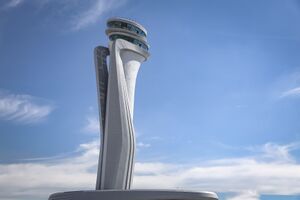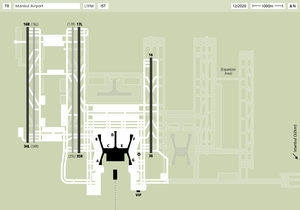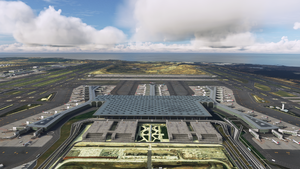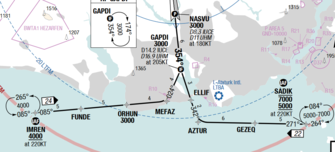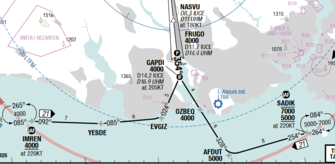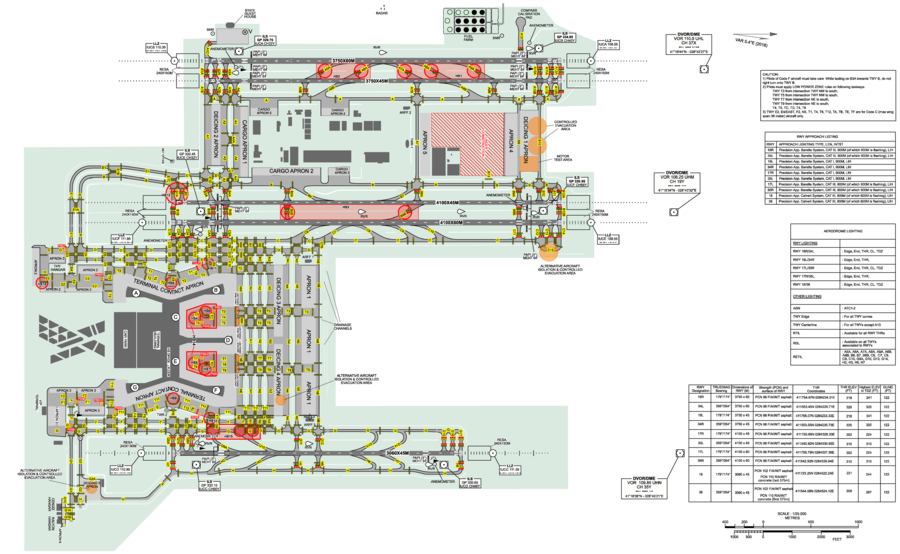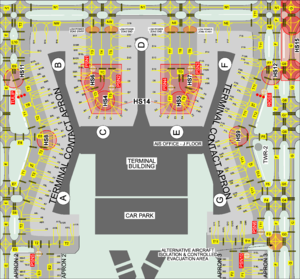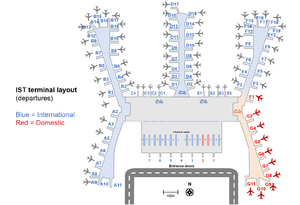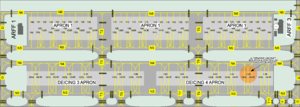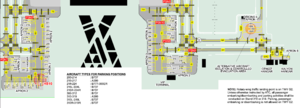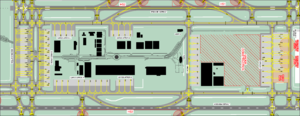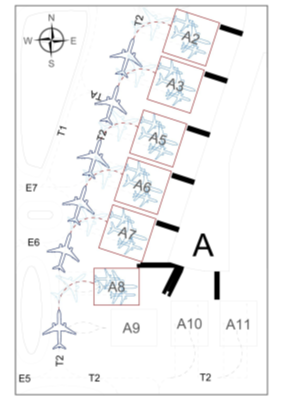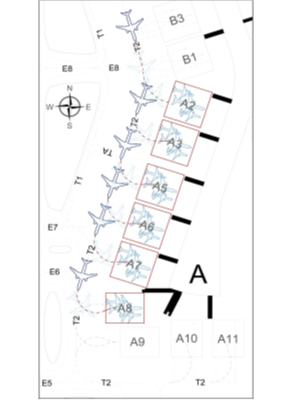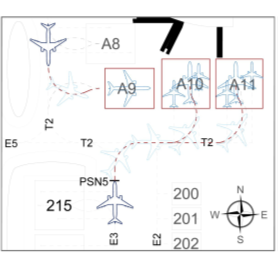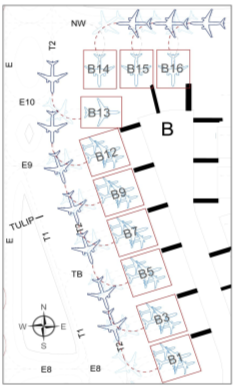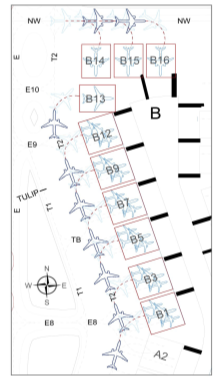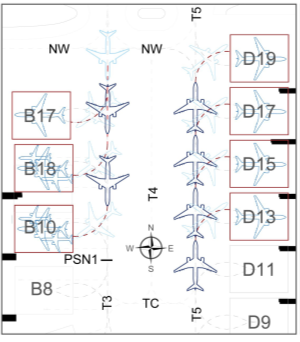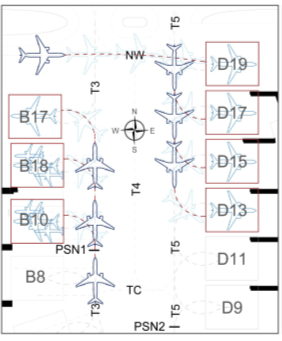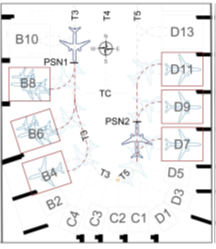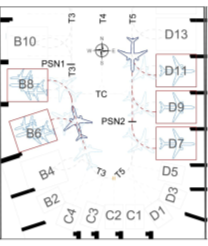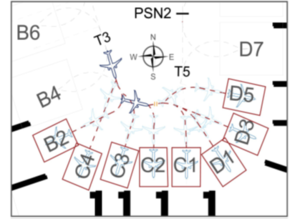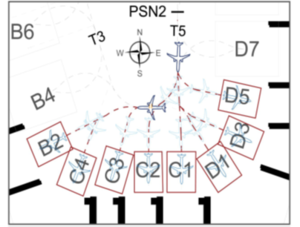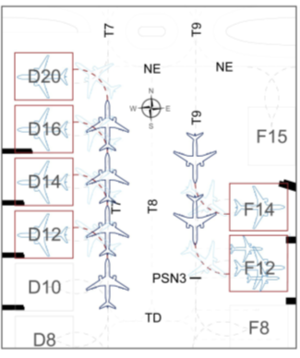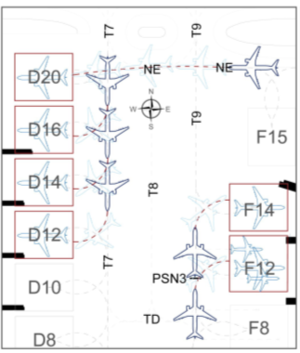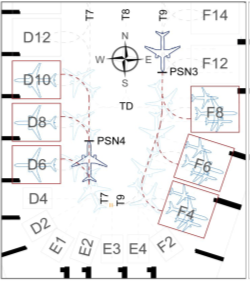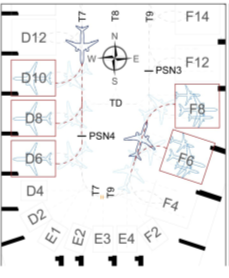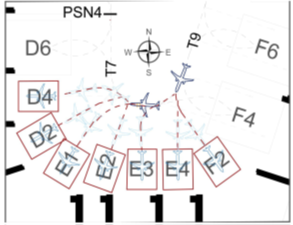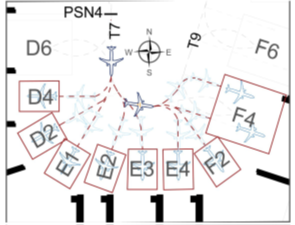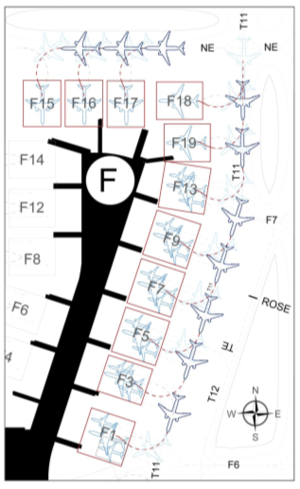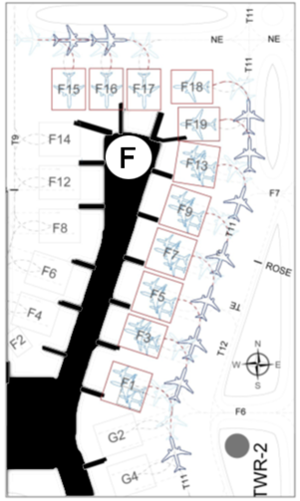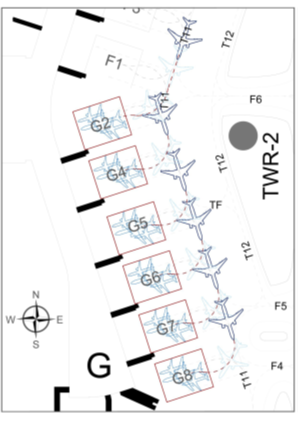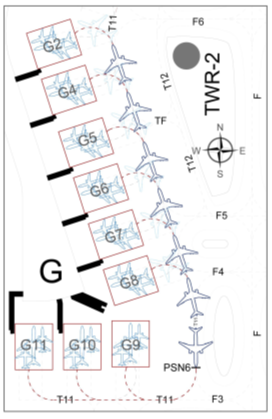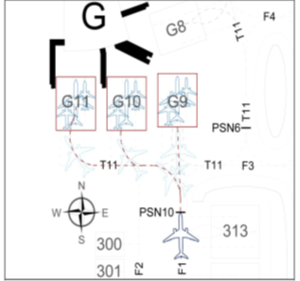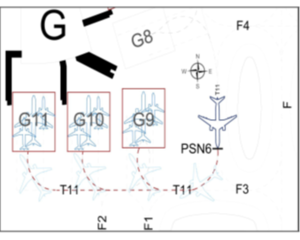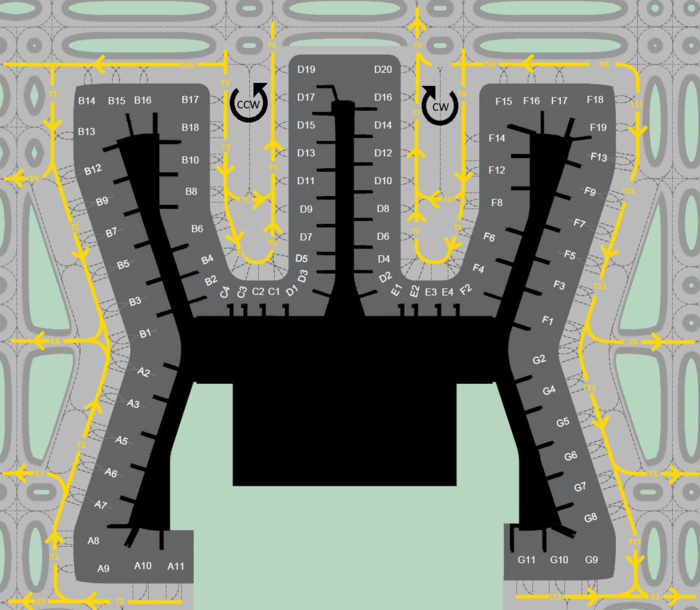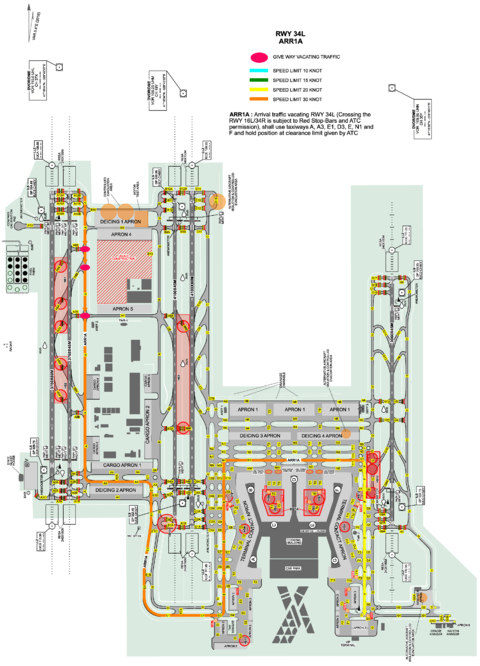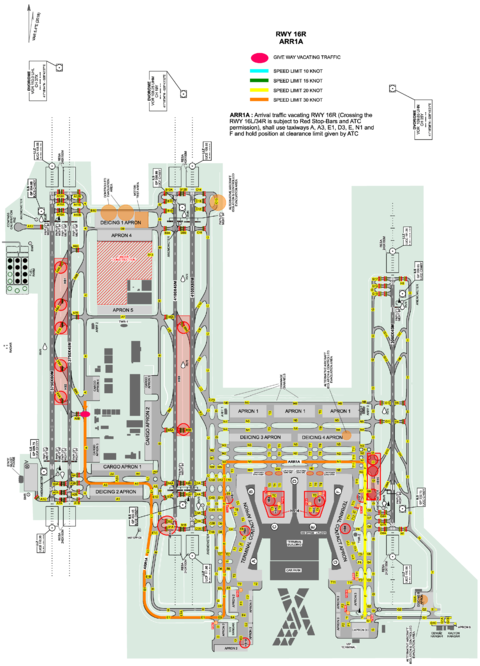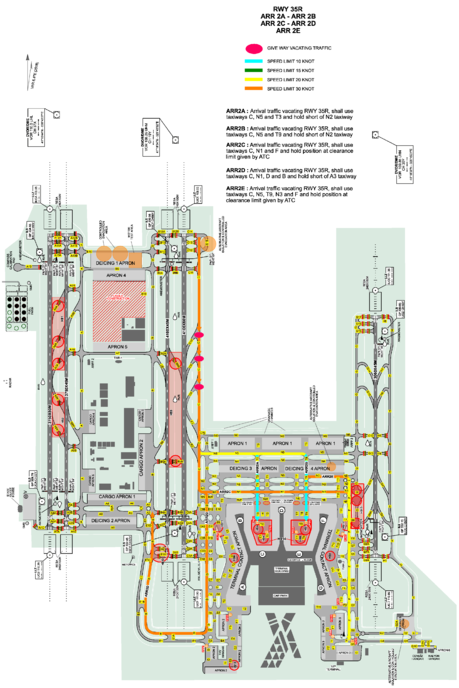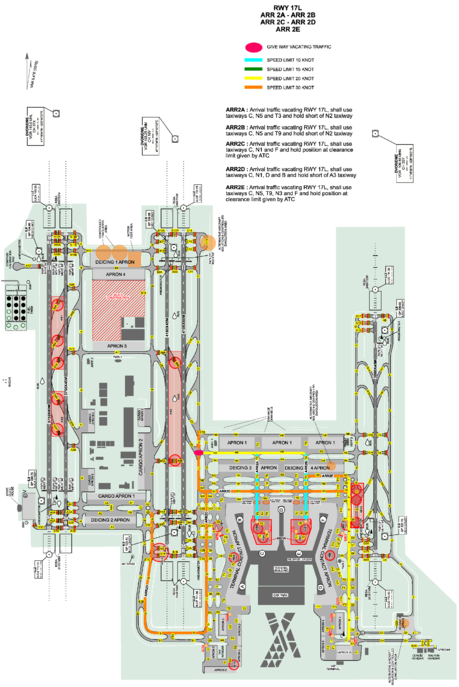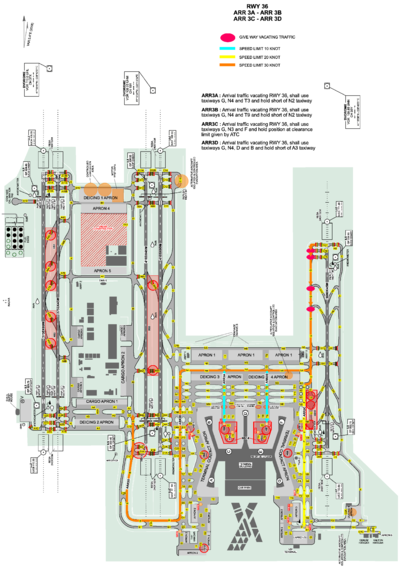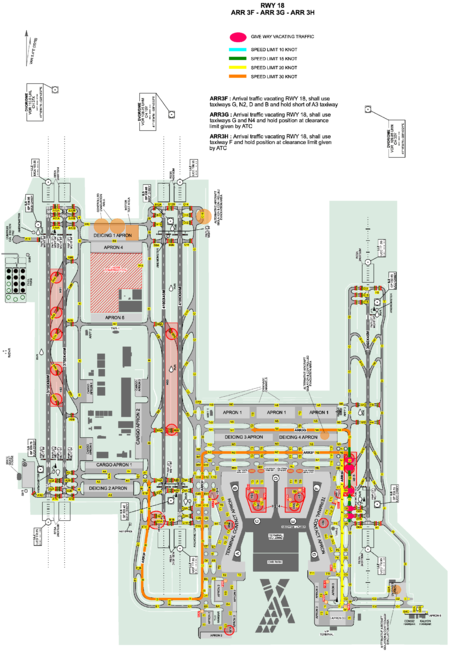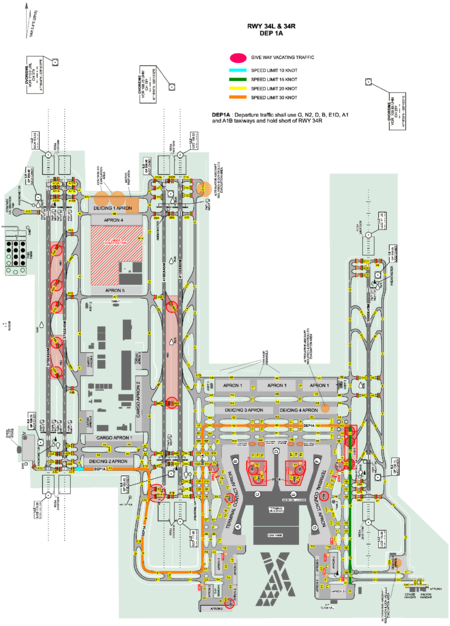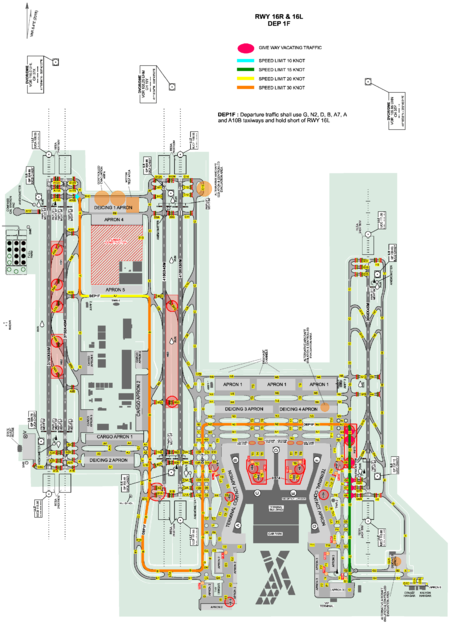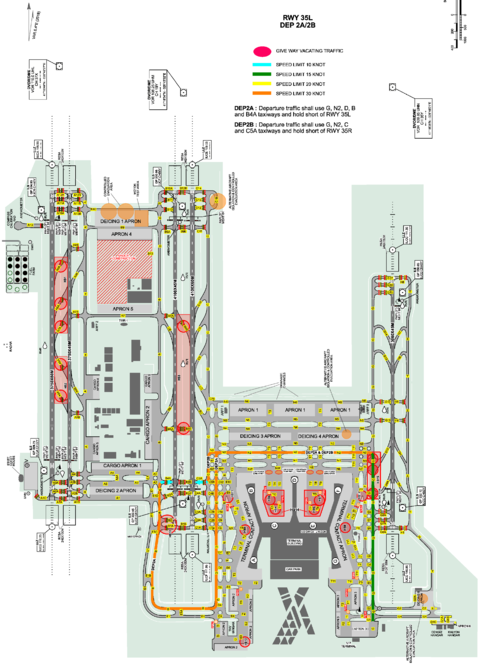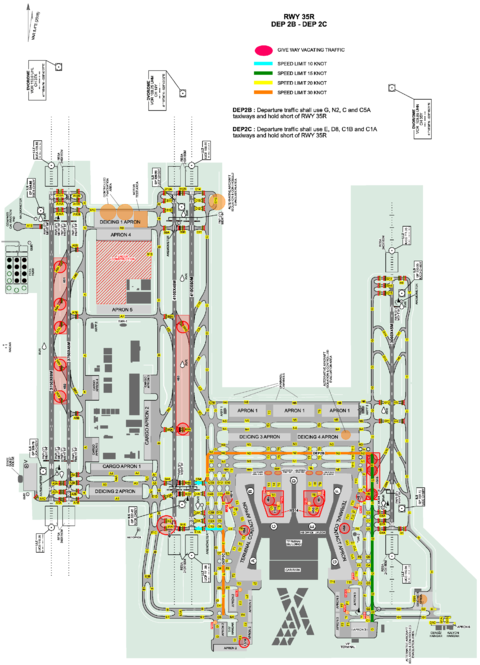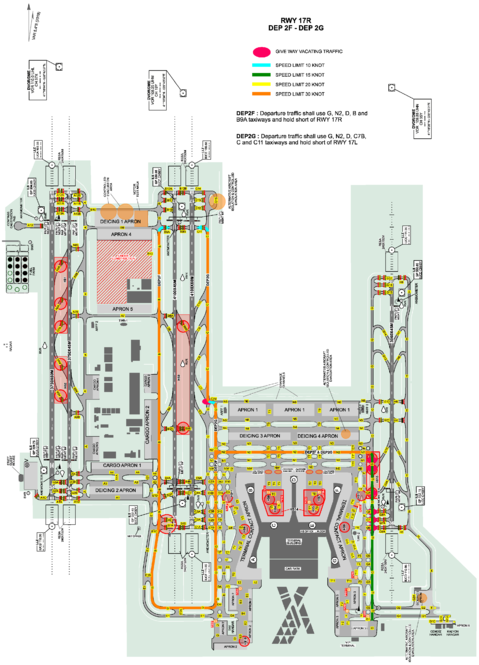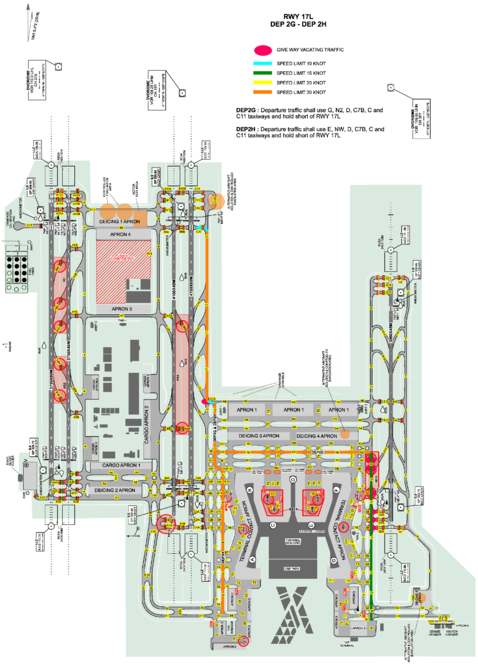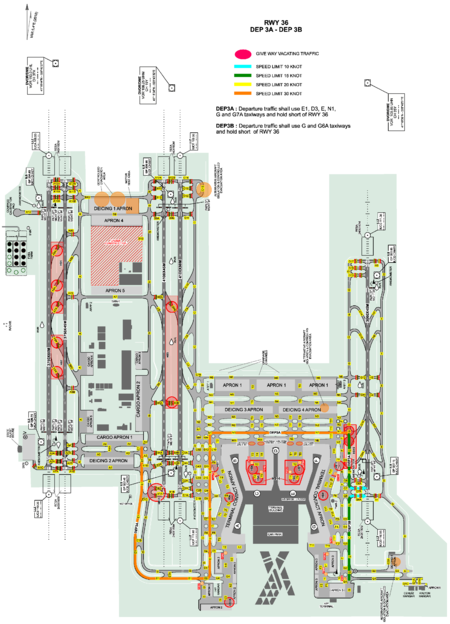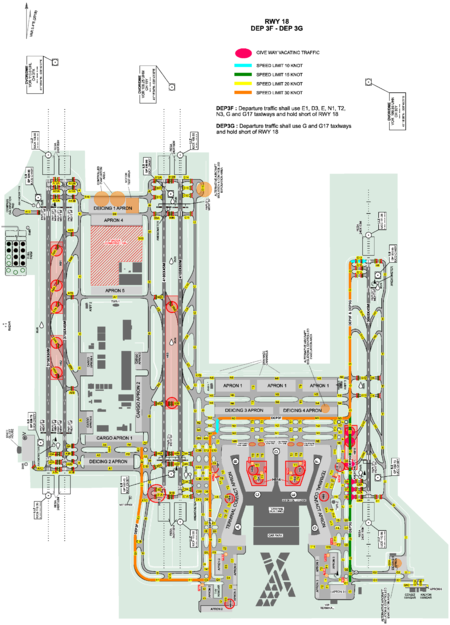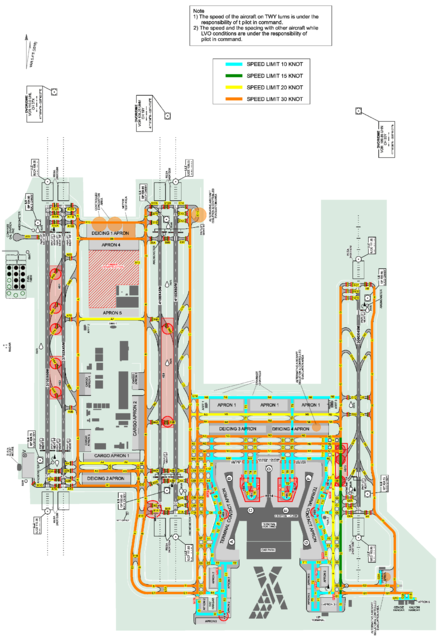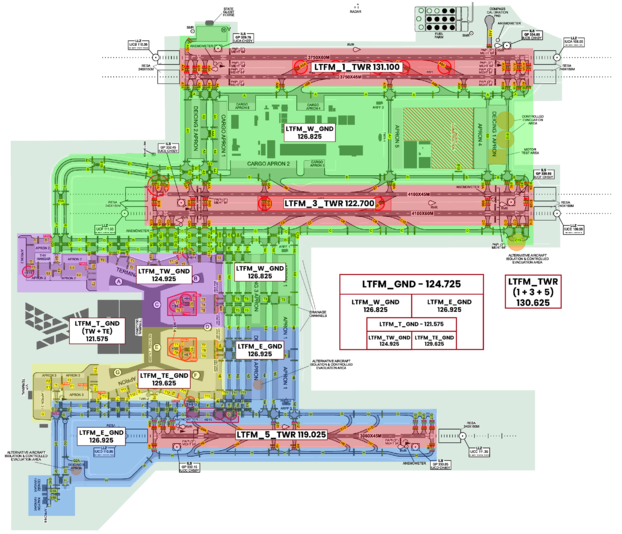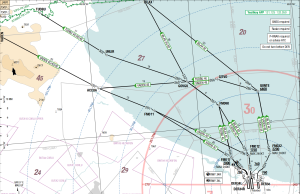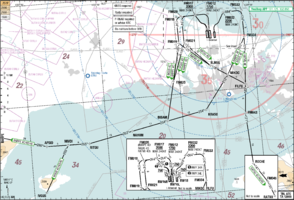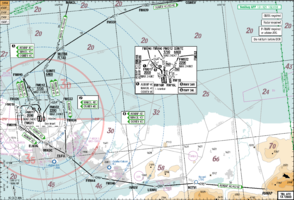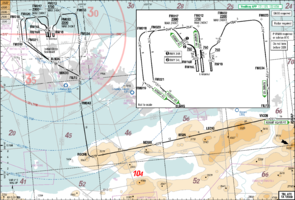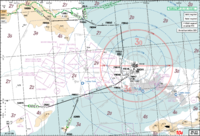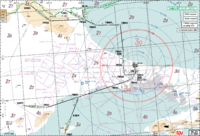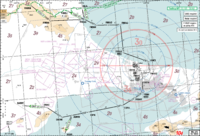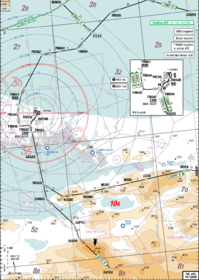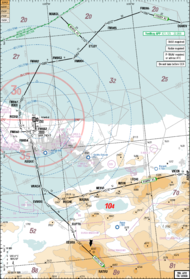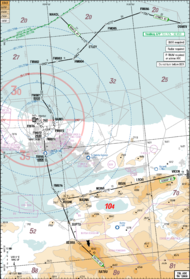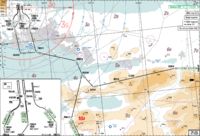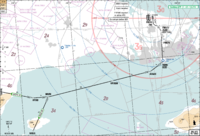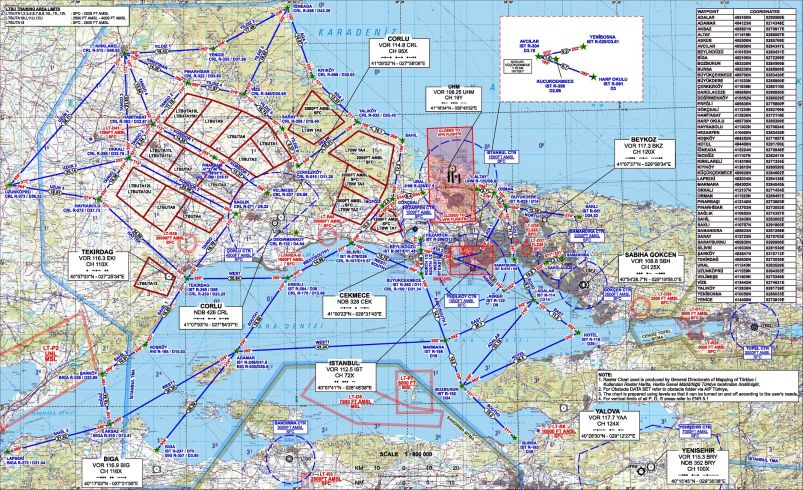Istanbul Airport: Difference between revisions
(added VFR section, waiting for image upload bug to be fixed to upload the VFR Chart) |
m (update support URL) |
||
| (5 intermediate revisions by the same user not shown) | |||
| Line 110: | Line 110: | ||
!Active Runway Configuration | !Active Runway Configuration | ||
|- | |- | ||
| | !North Config | ||
|- | |||
| | |||
{| class="wikitable" | {| class="wikitable" | ||
!Type | !Type | ||
| Line 130: | Line 132: | ||
<nowiki>*</nowiki>''not applicable to DRAMO and INBET STARs'' | <nowiki>*</nowiki>''not applicable to DRAMO and INBET STARs'' | ||
|2Q | |2Q | ||
|} | |}<nowiki>*</nowiki>Alternative: Only used by ATC. | ||
<nowiki>*</nowiki>Alternative: Only used by ATC. | |- | ||
!South Config | |||
|- | |- | ||
| | | | ||
{| class="wikitable" | {| class="wikitable" | ||
!Type | !Type | ||
| Line 153: | Line 156: | ||
<nowiki>*</nowiki>''not applicable to RILEX, RIXEN, SISPI STARs'' | <nowiki>*</nowiki>''not applicable to RILEX, RIXEN, SISPI STARs'' | ||
|2R | |2R | ||
|} | |}<nowiki>*</nowiki>Alternative: Only used by ATC. | ||
<nowiki>*</nowiki>Alternative: Only used by ATC. | |||
|} | |} | ||
As Istanbul Airport utilizes multiple configurations depending on traffic, weather, congestion, NOTAMs etc. You might be cleared to a different STAR compared to another traffic that is flying exactly the same route as you. Default designators for northern config (34/35/36) is 2A and default designator for southern configuration (16/17/18) is 2B. These STARs keep the traffic arriving west to use the west PMS and traffic arriving from east to use the east PMS. 2N and 2P STARs are designed to ease the workload of a PMS, by making the traffic to use the opposite PMS (traffic arriving from west to use the east PMS or to enter PMS from north instead of south at different altitude e.g). | As Istanbul Airport utilizes multiple configurations depending on traffic, weather, congestion, NOTAMs etc. You might be cleared to a different STAR compared to another traffic that is flying exactly the same route as you. Default designators for northern config (34/35/36) is 2A and default designator for southern configuration (16/17/18) is 2B. These STARs keep the traffic arriving west to use the west PMS and traffic arriving from east to use the east PMS. 2N and 2P STARs are designed to ease the workload of a PMS, by making the traffic to use the opposite PMS (traffic arriving from west to use the east PMS or to enter PMS from north instead of south at different altitude e.g). | ||
| Line 177: | Line 179: | ||
</gallery>[[File:Image.png|thumb|ILS-X 35R Approach (showing both IMREN and SADIK transition)|335x335px]] | </gallery>[[File:Image.png|thumb|ILS-X 35R Approach (showing both IMREN and SADIK transition)|335x335px]] | ||
=== Transitions and Approach Phase === | === Transitions and Approach Phase === | ||
As mentioned previously, Istanbul Airport utilizes Point-Merge System. Each PMS leads to last point of the STAR and '''the entry point of the approach transition'''. For northern config, IAF for west PMS is ''IMREN'', for east config it is ''SADIK''. For south config, IAF for west PMS is ''INSTA'' and for east PMS it is ''DIVDI''. '''Flying the correct transition is crucial and must'''. Each pilot is responsible for selecting the correct transition. This transition is '''NOT a STAR''' transition but transition for the approach procedure. There are different approach procedures and each has different transition phase (both laterally and vertically), go around procedure and used differently to streamline the independent parallel approach procedure . As a pilot, you must make sure you have programmed your FMS using the correct approach procedure and transition. ''' | As mentioned previously, Istanbul Airport utilizes Point-Merge System. Each PMS leads to last point of the STAR and '''the entry point of the approach transition'''. For northern config, IAF for west PMS is ''IMREN'', for east config it is ''SADIK''. For south config, IAF for west PMS is ''INSTA'' and for east PMS it is ''DIVDI''. '''Flying the correct transition is crucial and must'''. Each pilot is responsible for selecting the correct transition. This transition is '''NOT a STAR''' transition but transition for the approach procedure. There are different approach procedures and each has different transition phase (both laterally and vertically), go around procedure and used differently to streamline the independent parallel approach procedure . As a pilot, you must make sure you have programmed your FMS using the correct approach procedure and transition. '''Each pilot is responsible for selecting and flying the correct transition whether ATC is online or not.''' Since transitions are a must as they play a crucial role in the independent parallel approach procedure, pilot's must fly the transition both laterally and vertically at all times. If the transition is not selected correctly in the aircraft's FMS, the plane will fly directly to FAF, skipping the transition completely. This is not allowed for approach procedure into Istanbul as each approach procedure and transition is very different than one another, both laterally and vertically. You can see an example of how ILS-X and ILS-Z transition differs from the pictures (you can see they are both laterally and vertically different).[[File:ILS-Z 35R TRANSITION2.png|thumb|ILS-Z Approach (showing both IMREN and SADIK transition)|335x335px]] | ||
== Ground Layout == | == Ground Layout == | ||
Istanbul airport is on the list of biggest airports as per surface area, with staggering 76.5 million m<sup>2</sup> of land area. The airport has 5 runways, 34L/16R, 34R/16L, 35L/17R, 35R/17L and 36/18. Between RWYs 34 and 35, the main MRO and cargo area can be found. Between RWY 35 and 36, main passenger terminal and the stands can be found. Most gates and stands utilize MARS (Multiple Aircraft Ramp System). This increases the efficiency and gate usage significantly. With the MARS system, one gate can be shared by either 2 small to medium aircraft or 1 heavy (widebody) aircraft. In Istanbul Airport, MARS system uses L (as left) and R (as right) abbreviations for medium/split gates. For instance B4 gate is used by either 1 heavy aircraft or 2 medium aircrafts use B4L (Gate B 4 Left) and B4R (Gate B 4 Right). | Istanbul airport is on the list of biggest airports as per surface area, with staggering 76.5 million m<sup>2</sup> of land area. The airport has 5 runways, 34L/16R, 34R/16L, 35L/17R, 35R/17L and 36/18. Between RWYs 34 and 35, the main MRO and cargo area can be found. Between RWY 35 and 36, main passenger terminal and the stands can be found. Most gates and stands utilize MARS (Multiple Aircraft Ramp System). This increases the efficiency and gate usage significantly. With the MARS system, one gate can be shared by either 2 small to medium aircraft or 1 heavy (widebody) aircraft. In Istanbul Airport, MARS system uses L (as left) and R (as right) abbreviations for medium/split gates. For instance B4 gate is used by either 1 heavy aircraft or 2 medium aircrafts use B4L (Gate B 4 Left) and B4R (Gate B 4 Right). | ||
| Line 2,304: | Line 2,306: | ||
|Entire airport | |Entire airport | ||
|121.700 | |121.700 | ||
|- | |- | ||
! colspan="3" |Ground | ! colspan="3" |Ground | ||
| Line 2,575: | Line 2,573: | ||
== VFR in Istanbul TMA == | == VFR in Istanbul TMA == | ||
You can find the VFR chart for Istanbul TMA showing the VFR routings, VFR waypoints, training areas below. If you have any questions regarding this, you can reach out to our Air Traffic, Operation and Navigation department by opening a ticket. | You can find the VFR chart for Istanbul TMA showing the VFR routings, VFR waypoints, training areas below. If you have any questions regarding this, you can reach out to our Air Traffic, Operation and Navigation department by opening a ticket. | ||
[[File:LT AD 2 LTFM VFR en 2024-02-22.jpg|center|thumb|803x803px|Istanbul TMA VFR Chart]] | |||
== Feedback and Updates == | == Feedback and Updates == | ||
If you have any feedback, comments, suggestions or improvements regarding this page, please [https:// | If you have any feedback, comments, suggestions or improvements regarding this page, please [https://support.vatsim.tr/ open a ticket]. | ||
== References == | == References == | ||
<references /> | <references /> | ||
Latest revision as of 01:11, 29 October 2024
Istanbul Airport (IATA: IST, ICAO: LTFM) is the biggest airport in Turkiye. Located in north west of Istanbul, the airport is the busiest and biggest airport in Europe as per 2022 statistics of EuroControl[1]. The airport has 5 runways, fuel farm, dedicated cargo area consisting of 5 apron (29 heavy stands), several warehouses and facilities (biggest one being Turkish Cargo followed by DHL and UPS), and is home to world's biggest airport terminal (under one roof).
The airport has not been completed. As of January 2023, only Phase 1a and 1b is finished. The final phase of the airport includes 8 runways, 2 terminals with 1 satellite terminal with up to 200 million passenger/year capacity.
Sceneries
Payware
There are multiple payware options depending on the simulator for Istanbul Airport. You can find more information from the table below.
| Simulator | Developer | Publisher | Links |
|---|---|---|---|
| P3D v4/v5 | SceneryTR | SimMarket | https://secure.simmarket.com/scenerytr-stanbul-airport-ltfm.phtml |
| X-Plane 11 | SceneryTR/SimPort Team | Aerosoft | https://secure.simmarket.com/aerosoft-airport-istanbul-x-plane-11.phtml |
| Microsoft Flight Simulator 2020 | SceneryTR | SimMarket | Can be bought from MarketPlace
OR https://secure.simmarket.com/scenerytr-istanbul-airport-ltfm_msfs.phtml |
Freeware
There are also freeware options available for Istanbul Airport. However there is significant difference in quality.
| Simulator | Developer | Publisher | Links |
|---|---|---|---|
| FSX/P3D | Hakan Dağhan, Kamil Uzun, Erman Gökman Piliçoğlu, Muhteşem Fırtına Özçınar | Turkish Virtual | https://turkishvirtual.com/turkishvirtual_LTFM_scenerys.asp |
| X-Plane 11 | Mali Öğüdücü, Hayri Büberci, Kamil Uzun, Muhteşem Fırtına Özçınar | Turkish Virtual | https://turkishvirtual.com/turkishvirtual_LTFM_scenerys.asp |
| Microsoft Flight Simulator 2020 | Hayri Büberci, Mali Öğüdücü, Kamil Uzun, Muhteşem Fırtına Özçınar | Turkish Virtual | https://turkishvirtual.com/turkishvirtual_LTFM_scenerys.asp |
Preferential Runway System (PRS)
The term “Preferential RWY System (PRS)” shall be used to indicate the runway that, at a particular time, is considered by the ATC unit to be the most suitable for use by the aircraft expected to land at or take-off from the aerodrome, by taking into consideration aircraft performance, surface wind speed and its components. PRS Operations contribute to the optimum use of airspace and aerodrome capacity.
The Preferential Runways in Istanbul Airport (LTFM) are north configuration runways (34L/R & 35L/R & 36)
| RWYCC (Runway Condition Code) | Tail Wind Component (max) |
|---|---|
| RWYCC 6/6/6
(dry, maximum braking) |
10 KT (included) |
| When RWYCC is reported at least 5 for any each runway third
(worse than dry, low braking |
5 KT (included) |
- In the PRS operations, the above wind criteria depending on the runway surface condition shall be applied.
- During the PRS operations, ATC unit takes into account the ground wind, traffic situation, local meteorological conditions, environmental restrictions, technical infrastructure, noise abatement, etc.
- PRS operations will not be available under the following circumstances:
- The instrument approach/departure procedures available for the preferred RWY(s) are not convenient for landing and/ or take-off operations under the existing meteorological conditions
- When the preferred RWY(s) are dry (RWYCC[2] 6/6/6), the tail wind component is greater than 10 Kt,
- When RWYCC is reported at least 5 for any each the preferred RWY(s) third, the tail wind component is greater than 5 Kt,
- When RWYCC is reported at least 5 for any each the preferred RWY(s) third, there is a NOTAM/equivalent information (which may be included in the RCR) stating that the runway is slippery, ATIS announcement when PRS Operations are in progress shall be; “Preferential Runway Operations are in Progress”.
- RWYCC is reported 4 or less any each the preferred RWY(s) third,
- Meteorological conditions such as heavy rainfall, thunderstorm or wind-shear has been reported on the approach or climb path of the preferred RWY(s),
- Low visibility operations are in progress.
- ATIS announcement when PRS Operations are in progress shall be; “Preferential Runway Operations are in Progress”.
- Pilots unable to comply with PRS Operations shall notify the relevant ATC unit at the time of requesting start-up clearance, at the first contact or 20 minutes in advance of the ETA (which is earlier).
Arrival Procedures
Introduction
Istanbul Airport is located within Istanbul TMA (Terminal Manoeuvring Area). Istanbul TMA covers Istanbul Airport (LTFM), Sabiha Gokcen Airport (LTFJ), Ataturk Airport (LTBA), Samandira Airbase (LTBX), Corlu Ataturk Airport (LTBU), Hezarfen Municipal Airport (LTBW), Cengiz Topel Airport (LTBQ), Bursa Yunuseli Airport (LTBE) and Bursa Yenisehir Airport (LTBR). There are several more airports within the TMA however they are so small and not known that they are never used in VATSIM.
Istanbul Airport utilizes RNAV in all of its STAR procedures. In addition, P-RNAV (Precision-Area Navigation, RNP1) capability is required. If unable, pilot must inform the controller so that aircraft can be given radar vectors to final. Arrival into Istanbul Airport might seem complicated to some pilots however it is actually very simple. LTFM STARs utilize PMS (Point Merge System) for efficient airspace control, separation, and to control traffic flow within Yesilkoy TMA. All STARs utilize idle descent philosophy until PMS entry. These point merge systems act as an arc of a circle and ease air traffic control.
Important things to keep in mind:
- Vacating aircraft has priority at the intersection of the parallel taxiway. Which means, if you are vacating a RWY using rapid exit, the traffic on G, for example, should stop for you.
- After the runway is vacated, do not report vacated to TWR* and DO NOT STOP on rapid-exit taxiways.
- For runway 34L/16R, after landing cross 34R/16L, then join taxiway A to the south direction and contact GND.
- For runway 35R/17L, vacate to the C taxiway then contact GND without stopping.
- For runway 36/18, traffics should not vacate via G11 and G12 taxiways. Instead, pilots should use the rapid exit taxiways to G taxiway then contact GND.
*unless LVP is in progress. Check next section for more details.
Low Visibility Procedure
When LVP are in progress, every traffic must report "Vacated" to the TWR, as verbal confirmation from the traffic is mandatory and for the TWR to know the runway is available for the next traffic.
STARs
The STARs at Istanbul airport are designed to be ambiguous between the active runways. For instance, if northern config is active, RILEX2A STAR will end at IMREN waypoint, and IMREN is IAF (Initial Approach Fix) for all approach procedures for all northern runways. This means, whether you land at 34L, 35R or 36 (when north config is active), you still use the same STAR procedure for all runways. You can find the STAR designator table on the next page.
| Active Runway Configuration | ||||||||
|---|---|---|---|---|---|---|---|---|
| North Config | ||||||||
| ||||||||
| South Config | ||||||||
|
As Istanbul Airport utilizes multiple configurations depending on traffic, weather, congestion, NOTAMs etc. You might be cleared to a different STAR compared to another traffic that is flying exactly the same route as you. Default designators for northern config (34/35/36) is 2A and default designator for southern configuration (16/17/18) is 2B. These STARs keep the traffic arriving west to use the west PMS and traffic arriving from east to use the east PMS. 2N and 2P STARs are designed to ease the workload of a PMS, by making the traffic to use the opposite PMS (traffic arriving from west to use the east PMS or to enter PMS from north instead of south at different altitude e.g).
North Config
South Config
Transitions and Approach Phase
As mentioned previously, Istanbul Airport utilizes Point-Merge System. Each PMS leads to last point of the STAR and the entry point of the approach transition. For northern config, IAF for west PMS is IMREN, for east config it is SADIK. For south config, IAF for west PMS is INSTA and for east PMS it is DIVDI. Flying the correct transition is crucial and must. Each pilot is responsible for selecting the correct transition. This transition is NOT a STAR transition but transition for the approach procedure. There are different approach procedures and each has different transition phase (both laterally and vertically), go around procedure and used differently to streamline the independent parallel approach procedure . As a pilot, you must make sure you have programmed your FMS using the correct approach procedure and transition. Each pilot is responsible for selecting and flying the correct transition whether ATC is online or not. Since transitions are a must as they play a crucial role in the independent parallel approach procedure, pilot's must fly the transition both laterally and vertically at all times. If the transition is not selected correctly in the aircraft's FMS, the plane will fly directly to FAF, skipping the transition completely. This is not allowed for approach procedure into Istanbul as each approach procedure and transition is very different than one another, both laterally and vertically. You can see an example of how ILS-X and ILS-Z transition differs from the pictures (you can see they are both laterally and vertically different).
Ground Layout
Istanbul airport is on the list of biggest airports as per surface area, with staggering 76.5 million m2 of land area. The airport has 5 runways, 34L/16R, 34R/16L, 35L/17R, 35R/17L and 36/18. Between RWYs 34 and 35, the main MRO and cargo area can be found. Between RWY 35 and 36, main passenger terminal and the stands can be found. Most gates and stands utilize MARS (Multiple Aircraft Ramp System). This increases the efficiency and gate usage significantly. With the MARS system, one gate can be shared by either 2 small to medium aircraft or 1 heavy (widebody) aircraft. In Istanbul Airport, MARS system uses L (as left) and R (as right) abbreviations for medium/split gates. For instance B4 gate is used by either 1 heavy aircraft or 2 medium aircrafts use B4L (Gate B 4 Left) and B4R (Gate B 4 Right).
Main Passenger Terminal and Terminal Contact Apron
Passenger terminal at Istanbul Airport both house international and domestic traffic. The gates are split into piers and identifiers.
| Gates/Pier | International | Domestic |
|---|---|---|
| A Gates | X | |
| B Gates | X | |
| C Gates | X | |
| D Gates | X | |
| E Gates | X | |
| F Gates | X | |
| G Gates | X |
C and E gates are only medium gates and are connected directly to the main building. A, B, C, D, F and G gates are located in their respective piers.
A Pier
A gates/pier is only for international flights. Gate A9 is the only gate that does not have MARS system. Gate A2 is only the one of the 2 gates that is equipped with third jetbridge, which is used for A380 flights.
B Pier
B gates/pier is used located in international area of the terminal and only international flights use these gates. Gates B1, B3, B5, B6, B7, B8, B9, B10, B12 and B18 utilize MARS system. Gates B4, B13, B14, B15, B16, B17 are heavy gates. Gate B2 is only to be used by small to medium aircraft.
C Gates
C gates are located in the West Cul-de-Sac of the terminal complex and have only 4 gates. All gates (C1, C2, C3, C4) are to medium gates.
D Pier
D Pier is used heavily by long range flights due to being the most heavy gates. Out of 19 gates, only gates D1, D2, D3, D4 are medium gates. Rest of them are heavy only.
E Gates
Just like C gates, E gates have only gates (E1, E2, E3, E4). They are located in the East Cul-de-Sac.
F Pier
F pier has mix of gates and flights. Gate F2 is medium only whereas gates F3, F4, F5, F6, F7, F8, F9, F12, F13 use MARS. Gates F14, F15, F16, F17, F18, F19 are heavy only gates. F1 gate uses MARS however is domestic only.
G Pier
G pier is to be used only for domestic flights. Entire G pier utilizes MARS.
Apron 1
Apron 1 is located north of Terminal Area, situated between taxiways D and G. It contains 33 medium stands (100-132 and 149) and 16 MARS stands (133-148).
Apron 2 and 3
Apron 2 is situated south of A pier and Apron 3 is located south of G pier. Both aprons contain MARS and narrowbody-only stands. 2xx stands represent stands located in apron 2 and 3xx stands in apron 3. Stands 218, 219, 225 and 226 are used by Turkish Technic and should not be used. Stands 316, 317, 318, 319 is used only for VIP.
For Apron 2:
- 200 - 214 -> Medium gates
- 220 - 224 -> MARS
For Apron 3:
- 300 - 312 -> Medium gates
- 313 - 315 -> MARS
Cargo and MRO Aprons
Located between runways 34R/16L and 35L/17R, there are 5 cargo aprons and 2 MRO aprons. Cargo stands start with K. Stands K1, K2, K3, K4, K5, K6, K7, K8, K9 all utilize MARS wheres the remaining stands K10-K21 (used ONLY by Turkish Cargo) and K50-K57 are heavy gates. 4xx and 5xx stands are used only by Turkish Technic.
Pushback Procedures
Each gate/stand in Istanbul Airport has published standard and alternative pushback procedure. These procedures increase efficiency of the aprons, gates, ground movements and streamline the traffic flow through out the airport. You might see abbreviations such as PSN. There are "Pushback Positions" which act as point where aircraft should pushback to.
Southwest Area | A Pier
| Stand | Pushback Procedure | Caution | Phraseology |
|---|---|---|---|
| A2L thru
A2R |
Standard
The ACFT shall be pushed back following the pushback line onto TWY T2 to face North and continue push until TWY E8 will remain clear of ACFT. |
HS8
(Be aware of the ACFT pushbacks from stands A2L, A2, B1 and B1R). |
Pushback Approved
Face North |
| Alternate
The ACFT shall be pushed back following the pushback line onto TWY T2 to face South and continue push until TWY E8 will remain clear of ACFT. |
Pushback Approved
Face South | ||
| A3L thru
A7R |
Standard
The ACFT shall be pushed back following the pushback line onto TWY T2 to face North. |
Pushback Approved
Face North | |
| Alternate
The ACFT shall be pushed back following the pushback line onto TWY T2 to face South. |
Pushback Approved
Face South | ||
| A8L thru
A8R |
Standard
The ACFT shall be pushed back following the pushback line onto TWY T2 to face North. TWY E5 will remain clear of ACFT. |
Pushback Approved
Face North | |
| Alternate
The ACFT shall be pushed back following the pushback line onto TWY T2 to face South. |
Pushback Approved
Face South | ||
| A9 | Standard
The ACFT shall be pushed back following the pushback line onto TWY T2 to face South. |
Pushback Approved
Face South | |
| Alternate
The ACFT shall be pushed back following the pushback line onto TWY T2 to face North, then pulled forward until TWY E5 will remain clear of ACFT. |
Pushback Approved
Face North | ||
| A10
A11 |
Standard
The ACFT shall be pushed back following the pushback line onto TWY E3 to face North until its nosewheel is at the PSN5 point. |
E2 TWY
is CAT C. |
Pushback Approved
PSN5 |
| A10L, A10R
A11L, A11R |
Standard
The ACFT shall be pushed back following the pushback line onto TWY E3 to face North until its nosewheel is at the PSN5 point. |
Pushback Approved
PSN5 | |
| Alternate
The ACFT shall be pushed back following the pushback line onto TWY E2 to face North and continue push until TWY T2 will remain clear of ACFT. |
Pushback Approved
Face North on E2 TWY |
Terminal Contact Apron | Northwest Area
| Stand | Pushback Procedure | Caution | Phraseology |
|---|---|---|---|
| B1L thru
B1R |
Standard
The ACFT shall be pushed back following the pushback line onto TWY T2 to face South and continue push until TWY E8 will remain clear of ACFT. |
HS8
(Be aware of the ACFT pushbacks from stands A2L, A2, B1 and B1R). |
Pushback Approved
Face South |
| Alternate
The ACFT shall be pushed back following the pushback line onto TWY T2 to face North and continue push until TWY E8 will remain clear of ACFT. |
Pushback Approved
Face North | ||
| B3L thru B3R
B5L thru B5R B7L thru B7R B9L thru B9R B12L thru B12R B13 |
Standard
The ACFT shall be pushed back following the pushback line onto TWY T2 to face South. |
Pushback Approved
Face South | |
| Alternate
The ACFT shall be pushed back following the pushback line onto TWY T2 to face North. |
Pushback Approved
Face North | ||
| B14
B15 B16 |
Standard
The ACFT shall be pushed back following the pushback line onto TWY NW to face West. |
The ACFT
pushing back from stand B14 facing East should pull forward until T2 TWY is clear. |
Pushback Approved
Face West |
| Alternate
The ACFT shall be pushed back following the pushback line onto TWY NW to face East. |
Pushback Approved
Face East |
Terminal Contact Apron | West Cul-de-Sac Area
| Stand | Pushback Procedure | Caution | Phraseology |
|---|---|---|---|
| B10L thru
B10R B17 B18L thru B18R |
Standard
The ACFT shall be pushed back following the pushback line onto TWY T3 facing South. Taxi out via TC TWY. |
The ACFT
pushing back from stand B17 should pull forward until NW TWY is clear. CAT D and E ACFTs pushing back face South shall use TWY TC. |
Pushback Approved
Face South |
| Alternate
The ACFT shall be pushed back following the pushback line onto TWY T3 facing North. |
Pushback Approved
Face North | ||
| D13
D15 D17 |
Standard
The ACFT shall be pushed back following the pushback line onto TWY T5 facing North. |
CAT D and E
ACFTs pushing back face South shall use TWY TC. |
Pushback Approved
Face North |
| Alternate
The ACFT shall be pushed back following the pushback line onto TWY T5 facing South. |
Pushback Approved
Face South | ||
| D19 | Standard
The ACFT shall be pushed back following the pushback line onto TWY T5 facing North. |
Pushback Approved
Face North | |
| Alternate
The ACFT shall be pushed back following the pushback line onto TWY NW facing East and continue push until TWY T3 will remain clear of ACFT. |
Pushback Approved
Face East on NW TWY | ||
| B4 | Standard
The ACFT shall be pushed back following the pushback line onto TWY T3 facing South and continue push until its nosewheel is at PSN1 point. Taxi out via TC TWY. |
HS4
(Be aware of the ACFT pushbacks from stands B2, B4, C1, C2, C3, C4, D1, D3 and D5). |
Pushback Approved
PSN1 |
| Alternate
The ACFT shall be pushed back following the pushback line onto TWY T3 facing South, then pulled forward until its nosewheel is at the PSN2 point on TWY T5 facing North. |
Pushback Approved
PSN2 | ||
| B6L thru
B6R B8L thru B8R |
Standard
The ACFT shall be pushed back following the pushback line onto TWY T3 facing South and continue push until its nosewheel is at the PSN1 point.Taxi out via TC TWY. |
HS6
(Be aware of the ACFT pushbacks from stands B6R and B8L). CAT D and E ACFTs pushing back face South shall use TWY TC. |
Pushback Approved
PSN1 |
| Alternate
The ACFT shall be pushed back following the pushback line onto TWY T3 facing North abeam stand B6, TWY TC will remain clear of ACFT. |
Pushback Approved
Face North Abeam Stand B6 | ||
| D7
D9 D11 |
Standard
The ACFT shall be pushed back following the pushback line onto TWY T5 facing North, then pulled forward until its nosewheel is at the PSN2 point. |
CAT D and E
ACFT pushing back face South shall use TWY TC. |
Pushback Approved
PSN2 |
| Alternate
The ACFT shall be pushed back following the pushback line onto TWY T5 facing South and continue push until abeam stand D11. Taxi out via TC TWY. |
Pushback Approved
Face South Abeam Stand D11 | ||
| B2
C3 C4 |
Standard
The ACFT shall be pushed back following the pushback line onto TWY T3 facing South. Taxi out via T5 TWY. |
HS4
(Be aware of the ACFT pushbacks from stands B2, B4, C1, C2, C3, C4, D1, D3 and D5). |
Pushback Approved
Face South on T3 TWY |
| Alternate
The ACFT shall be pushed back following the pushback line onto TWY facing West abeam stand C2. Taxi out via T3 TWY. |
Pushback Approved
Face West | ||
| C1
C2 D1 D3 D5 |
Standard
The ACFT shall be pushed back following the pushback line onto TWY facing East abeam stand C3. Taxi out via T5 TWY. |
HS4
(Be aware of the ACFT pushbacks from stands B2, B4, C1, C2, C3, C4, D1, D3 and D5). |
Pushback Approved
Face East |
| Alternate
The ACFT shall be pushed back following the pushback line onto TWY T5 facing South abeam stand D7. Taxi out via T3 TWY. |
Pushback Approved
Face South on T5 TWY |
Terminal Contact Apron | East Cul-de-Sac Area
| Stand | Pushback Procedure | Caution | Phraseology |
|---|---|---|---|
| D12
D14 D16 |
Standard
The ACFT shall be pushed back following the pushback line onto TWY T7 facing North. |
CAT D and E
ACFTs pushing back face South shall use TWY TD. |
Pushback Approved
Face North |
| Alternate
The ACFT shall be pushed back following the pushback line onto TWY T7 facing South. |
Pushback Approved
Face South | ||
| D20 | Standard
The ACFT shall be pushed back following the pushback line onto TWY T7 facing North. |
Pushback Approved
Face North | |
| Alternate
The ACFT shall be pushed back following the pushback line onto TWY NE facing West and continue push until TWY T9 will remain clear of ACFT. |
Pushback Approved
Face Wast on NE TWY | ||
| F12L thru
F12R F14 |
Standard
The ACFT shall be pushed back following the pushback line onto TWY T9 facing South. |
CAT D and E
ACFTs pushing back face South shall use TWY TD. |
Pushback Approved
Face South |
| Alternate
The ACFT shall be pushed back following the pushback line onto TWY T9 facing North. |
Pushback Approved
Face North | ||
| D6
D8 D10 |
Standard
The ACFT shall be pushed back following the pushback line onto TWY T7 facing North, then pulled forward until its nosewheel is at the PSN4 point. |
CAT D and E
ACFTs pushing back face South shall use TWY TD. |
Pushback Approved
PSN4 |
| Alternate
The ACFT shall be pushed back following the pushback line onto TWY T7 facing South and continue push until abeam stand D10. |
Pushback Approved
Face South Abeam Stand D10 | ||
| F4L thru
F4R |
Standard
The ACFT shall be pushed back following the pushback line onto TWY T9 facing South and continue push until its nosewheel is at the PSN3 point. |
HS5
(Be aware of the ACFT pushbacks from stands D2, D4, E1, E2, E3, E4, F2, F4L, F4 and F4R). |
Pushback Approved
PSN3 |
| F4 | Alternate
The ACFT shall be pushed back following the pushback line onto TWY T9 facing South then pulled forward until its nosewhell is at the PSN 4 on TWY T7 face North. |
Pushback Approved
PSN4 | |
| F4L
F4R |
Alternate
The ACFT shall be pushed back following the pushback line onto TWY facing East abeam stand E3. Taxi out via T9 TWY. |
Pushback Approved
Face East | |
| F6L thru
F6R F8L thru F8R |
Standard
The ACFT shall be pushed back following the pushback line onto TWY T9 facing South and continue push until its nosewheel is at the PSN3 point. |
HS7
(Be aware of the ACFT pushbacks from stands F6L and F8R) CAT D and E ACFTs pushing back face South shall use TWY TD. |
Pushback Approved
PSN3 |
| Alternate
The ACFT shall be pushed back following the pushback line onto TWY T9 facing North, then pulled forward until abeam stand F6. |
Pushback Approved
Face North Abeam Stand F6 | ||
| D2
D4 E1 E2 |
Standard
The ACFT shall be pushed back following the pushback line onto TWY facing West abeam stand E3. Taxi out via T7 TWY. |
HS5
(Be aware of the ACFT pushbacks from stands D2, D4, E1, E2, E3, E4, F2, F4L, F4 and F4R). |
Pushback Approved
Face West |
| Alternate
The ACFT shall be pushed back following the pushback line onto TWY T7 facing South abeam D6. Taxi out via T9 TWY. |
Pushback Approved
Face South on T7 TWY | ||
| E3 | Standard
The ACFT shall be pushed back following the pushback line onto TWY T9 facing South abeam stand F4. Taxi out via T7 TWY. |
HS5
(Be aware of the ACFT pushbacks from stands D2, D4, E1, E2, E3, E4, F2, F4L, F4 and F4R). |
Pushback Approved
Face South on T9 TWY |
| Alternate
The ACFT shall be pushed back following the pushback line onto TWY T7 facing South abeam stand D6. Taxi out via T9 TWY. |
Pushback Approved
Face South on T7 TWY | ||
| E4
F2 |
Standard
The ACFT shall be pushed back following the pushback line onto TWY T9 facing South abeam stand F4 Taxi out via T7 TWY. |
HS5
(Be aware of the ACFT pushbacks from stands D2, D4, E1, E2, E3, E4, F2, F4L, F4 and F4R). |
Pushback Approved
Face South on T9 TWY |
| Alternate
The ACFT shall be pushed back following the pushback line onto TWY facing East abeam stand E3. Taxi out via T9 TWY. |
Pushback Approved
Face East |
Terminal Contact Apron | Northeast area
| Stand | Pushback Procedure | Caution | Phraseology |
|---|---|---|---|
| F1L thru
F1R |
Standard
The ACFT shall be pushed back following the pushback line onto TWY T11 facing South and continue push until TWY F6 will remain clear of ACFT. |
HS9
(Be aware of the ACFT pushbacks from stands F1L, F1 and G2, G2R). |
Pushback Approved
Face South |
| Alternate
The ACFT shall be pushed back following the pushback line onto TWY T11 facing North and continue push until TWY F6 will remain clear of ACFT. |
Pushback Approved
Face North | ||
| F3L thru F3R
F5L thru F5R F7L thru F7R F9L thru F9R F13L thru F13R F18 F19 |
Standard
The ACFT shall be pushed back following the pushback line onto TWY T11 facing South. |
Pushback Approved
Face South | |
| Alternate
The ACFT shall be pushed back following the pushback line onto TWY T11 facing North. |
Pushback Approved
Face North | ||
| F15
F16 F17 |
Standard
The ACFT shall be pushed back following the pushback line onto TWY NE facing West. |
The ACFT
pushing back from Stand F15 should pull forward until T9 TWY is clear. |
Pushback Approved
Face West |
| Alternate
The ACFT shall be pushed back following the pushback line onto TWY NE facing East. |
Pushback Approved
Face East | ||
| G2L thru
G2R |
Standard
The ACFT shall be pushed back following the pushback line onto TWY T11 facing South and continue push until TWY F6 will remain clear of ACFT. |
HS9
(Be aware of the ACFT pushbacks from stands F1L, F1 and G2, G2R). |
Pushback Approved
Face South |
| Alternate
The ACFT shall be pushed back following the pushback line onto TWY T11 facing North and continue push until TWY F6 will remain clear of ACFT. |
Pushback Approved
Face North | ||
| G4L thru
G8R |
Standard
The ACFT shall be pushed back following the pushback line onto TWY T11 facing South. |
HS5
(Be aware of the ACFT pushbacks from stands D2, D4, E1, E2, E3, E4, F2, F4L, F4 and F4R). |
Pushback Approved
Face South |
| Alternate
The ACFT shall be pushed back following the pushback line onto TWY T11 facing North. |
Pushback Approved
Face North | ||
| D2
D4 E1 E2 |
Standard
The ACFT shall be pushed back following the pushback line onto TWY facing West abeam stand E3. Taxi out via T7 TWY. |
HS5
(Be aware of the ACFT pushbacks from stands D2, D4, E1, E2, E3, E4, F2, F4L, F4 and F4R). |
Pushback Approved
Face West |
| Alternate
The ACFT shall be pushed back following the pushback line onto TWY T7 facing South abeam D6. Taxi out via T9 TWY. |
Pushback Approved
Face North Abeam Stand F6 | ||
| E3 | Standard
The ACFT shall be pushed back following the pushback line onto TWY T9 facing South abeam stand F4. Taxi out via T7 TWY. |
HS5
(Be aware of the ACFT pushbacks from stands D2, D4, E1, E2, E3, E4, F2, F4L, F4 and F4R). |
Pushback Approved
Face South on T9 TWY |
| Alternate
The ACFT shall be pushed back following the pushback line onto TWY T7 facing South abeam stand D6. Taxi out via T9 TWY. |
Pushback Approved
Face South on T7 TWY | ||
| E4
F2 |
Standard
The ACFT shall be pushed back following the pushback line onto TWY T9 facing South abeam stand F4 Taxi out via T7 TWY. |
HS5
(Be aware of the ACFT pushbacks from stands D2, D4, E1, E2, E3, E4, F2, F4L, F4 and F4R). |
Pushback Approved
Face South on T9 TWY |
| Alternate
The ACFT shall be pushed back following the pushback line onto TWY facing East abeam stand E3. Taxi out via T9 TWY. |
Pushback Approved
Face East |
Terminal Contact Apron | Southeast Area
| Stand | Pushback Procedure | Caution | Phraseology |
|---|---|---|---|
| G2L thru
G2R |
Standard
The ACFT shall be pushed back following the pushback line onto TWY T11 facing South and continue push until TWY F6 will remain clear of ACFT. |
HS9
(Be aware of the ACFT pushbacks from stands F1L, F1 and G2, G2R). |
Pushback Approved
Face South |
| Alternate
The ACFT shall be pushed back following the pushback line onto TWY T11 facing North and continue push until TWY F6 will remain clear of ACFT. |
Pushback Approved
Face North | ||
| G4L thru
G8R |
Standard
The ACFT shall be pushed back following the pushback line onto TWY T11 facing South. |
HS5
(Be aware of the ACFT pushbacks from stands D2, D4, E1, E2, E3, E4, F2, F4L, F4 and F4R). |
Pushback Approved
Face South |
| Alternate
The ACFT shall be pushed back following the pushback line onto TWY T11 facing North. |
Pushback Approved
Face North | ||
| G9L thru
G9R |
Standard
The ACFT shall be pushed back following the pushback line onto TWY F1 facing North and continue push until its nosewheel is at the PSN10 point. |
F2 TWY
is CAT C. |
Pushback Approved
PSN10 |
| Alternate
The ACFT shall be pushed back following the pushback line onto TWY T11 facing West and continue push until its nosewheel is at the PSN6 point facing South. |
Pushback Approved
PSN6 | ||
| G10L thru
G11R |
Standard
The ACFT shall be pushed back following the pushback line onto TWY T11 facing West then following the pushback line onto TWY F1 facing North and continue push until its nosewheel is at the PSN10 point. |
F2 TWY
is CAT C. |
Pushback Approved
PSN10 |
| Alternate
The ACFT shall be pushed back following the pushback line onto TWY T11 facing West and continue push until its nosewheel is at the PSN6 point facing South. |
Pushback Approved
PSN6 | ||
| G4L thru
G8R |
Standard
The ACFT shall be pushed back following the pushback line onto TWY T11 facing South. |
HS5
(Be aware of the ACFT pushbacks from stands D2, D4, E1, E2, E3, E4, F2, F4L, F4 and F4R). |
Pushback Approved
Face South |
| Alternate
The ACFT shall be pushed back following the pushback line onto TWY T11 facing North. |
Pushback Approved
Face North |
Apron 1
| Stand | Pushback Procedure | Caution | Phraseology |
|---|---|---|---|
| 100 thru
109 |
Standard
The ACFT shall be pushed back following the pushback line onto TWY N6 facing East. |
Pushback Approved
Face East | |
| Alternate
The ACFT shall be pushed back following the pushback line onto TWY N6 facing West. |
Pushback Approved
Face West | ||
| 110 thru
121 |
Standard
The ACFT shall be pushed back following the pushback line onto TWY N6 facing West. |
Pushback Approved
Face West | |
| Alternate
The ACFT shall be pushed back following the pushback line onto TWY N6 facing East. |
Pushback Approved
Face East | ||
| 122 thru
131 |
Standard
The ACFT shall be pushed back following the pushback line onto TWY N6 facing West. |
Pushback Approved
Face West | |
| Alternate
The ACFT shall be pushed back following the pushback line onto TWY N6 facing East. |
Pushback Approved
Face East | ||
| 132 thru
137R |
Standard
The ACFT shall be pushed back following the pushback line onto TWY N5 facing East. |
The ACFT
pushes on a live TWY that may delay other taxiing ACFT. |
Pushback Approved
Face East |
| Alternate
The ACFT shall be pushed back following the pushback line onto TWY N5 facing West. |
Pushback Approved
Face West | ||
| 138L thru
143R |
Standard
The ACFT shall be pushed back following the pushback line onto TWY N5 facing East. |
The ACFT
pushes on a live TWY that may delay other taxiing ACFT. |
Pushback Approved
Face East |
| Alternate
The ACFT shall be pushed back following the pushback line onto TWY N5 facing West. |
Pushback Approved
Face West | ||
| 144L thru
149 |
Standard
The ACFT shall be pushed back following the pushback line onto TWY N5 facing West. |
The ACFT
pushes on a live TWY that may delay other taxiing ACFT. |
Pushback Approved
Face West |
| Alternate
The ACFT shall be pushed back following the pushback line onto TWY N5 facing East. |
Pushback Approved
Face East |
Apron 2
| Stand | Pushback Procedure | Caution | Phraseology |
|---|---|---|---|
| 200 thru
207 |
Standard
The ACFT shall be pushed back following the pushback line onto TWY E2 to face North. |
Pushback Approved
Face North | |
| Alternate
The ACFT shall be pushed back following the pushback line onto TWY E2 to face South. |
Pushback Approved
Face South | ||
| 215L thru
217R |
Standard
The ACFT shall be pushed back following the pushback line onto TWY E3 to face North. |
Pushback Approved
Face North | |
| Alternate
The ACFT shall be pushed back following the pushback line onto TWY E3 to face South. |
Pushback Approved
Face South | ||
| 220L thru
220R |
Standard
The ACFT shall be pushed back following the pushback line onto TWY D to face East. |
HS10
(Be aware of the ACFT pushbacks from stands 214 and 220). |
Pushback Approved
Face East |
| Alternate
The ACFT shall be pushed back following the pushback line onto TWY E3 to face South and continue push until D TWY is clear. |
Pushback Approved
Face South on E3 TWY | ||
| 221L thru
221R |
Standard
The ACFT shall be pushed back following the pushback line onto TWY D to face East. |
E2 TWY
is CAT C. |
Pushback Approved
Face East |
| Alternate
The ACFT shall be pushed back following the pushback line onto TWY N5 facing West. |
Pushback Approved
Face West | ||
| 222L thru
222R |
Standard
The ACFT shall be pushed back following the pushback line onto TWY D to face East. |
Pushback Approved
Face East | |
| Alternate
The ACFT shall be pushed back following the pushback line onto TWY D to face West. |
Pushback Approved
Face West | ||
| 223L thru
223R |
Standard
The ACFT shall be pushed back following the pushback line onto TWY D to face East, then pulled forward until abeam stand 223. |
Pushback Approved
Face East | |
| Alternate
The ACFT shall be pushed back following the pushback line onto TWY D to face West. |
Pushback Approved
Face West | ||
| 224L thru
224R |
Standard
The ACFT shall be pushed back following the pushback line onto TWY D to face South. |
Pushback Approved
Face South | |
| Alternate
The ACFT shall be pushed back following the pushback line onto TWY D to face West. |
Pushback Approved
Face West | ||
| 208 thru
212 |
Standard
The ACFT shall be pushed back following the pushback line onto TWY E2 to face North. |
Pushback Approved
Face North | |
| Alternate
The ACFT shall be pushed back following the pushback line onto TWY E2 to face South. |
Pushback Approved
Face South | ||
| 213, 214 | Standard
The ACFT shall be pushed back following the pushback line onto TWY D to face East. |
HS10
(Be aware of the ACFT pushbacks from stands 214 and 220). |
Pushback Approved
Face East |
| Alternate
The ACFT shall be pushed back following the pushback line onto TWY E2 to face South. |
Pushback Approved
Face South | ||
| 218L thru
218R |
Standard
The ACFT shall be pushed back following the pushback line onto TWY D to face North, then pulled forward until its nosewheel is at the PSN7 point. |
Pushback Approved
PSN7 | |
| Alternate
The ACFT shall be pushed back following the pushback line onto TWY D to face South, then pulled forward until TWY E1 will remain clear of ACFT. |
Pushback Approved
Face South | ||
| 219L thru
219R |
Standard
The ACFT shall be pushed back following the pushback line onto TWY D to face North, then pulled forward until its nosewheel is at the PSN7 point. |
Pushback Approved
PSN7 | |
| Alternate
The ACFT shall be pushed back following the pushback line onto TWY D to face South. |
Pushback Approved
Face South |
Apron 3
| Stand | Pushback Procedure | Caution | Phraseology |
|---|---|---|---|
| 300 thru
312 |
Standard
The ACFT shall be pushed back following the pushback line onto TWY F2 facing South. |
Alternate
pushback is not suitable for stands 311 and 312. |
Pushback Approved
Face South |
| Alternate
The ACFT shall be pushed back following the pushback line onto TWY F2 facing North. |
Pushback Approved
Face North | ||
| 313L thru
315R |
Standard
The ACFT shall be pushed back following the pushback line onto TWY F1 facing South. |
The ACFTs
pushing back from stands 313L thru 313R should pull forward until TWY T11 is clear. |
Pushback Approved
Face South |
| Alternate
The ACFT shall be pushed back following the pushback line onto TWY F1 facing North. |
Pushback Approved
Face North | ||
| 316L thru
317R |
Standard
The ACFT shall be pushed back following the pushback line onto TWY D to face East. |
F2 TWY
is CAT C. |
Pushback Approved
PSN8 |
| 318L thru
319R |
Standard
The ACFT shall be pushed back following the pushback line onto TWY G facing South and continue push until its nosewheel is at the PSN9 point facing East on G1 TWY. |
Pushback Approved
PSN9 |
Cargo Aprons 1 Thru 5
| Stand | Pushback Procedure | Caution | Phraseology |
|---|---|---|---|
| K1L thru
K9R |
Standard
The ACFT shall be pushed back following the pushback line onto TWY A4 facing West. |
Pushback Approved
Face West | |
| Alternate
The ACFT shall be pushed back following the pushback line onto TWY A4 facing East. |
Pushback Approved
Face East | ||
| K10 thru
K21 |
Standard
The ACFT shall be pushed back following the pushback line onto TWY B facing South. |
The ACFT
pushes on a live TWY that may delay other taxiing ACFT. |
Pushback Approved
Face South |
| Alternate
The ACFT shall be pushed back following the pushback line onto TWY B facing North. |
Pushback Approved
Face North | ||
| K50 thru K57 | Standard
The ACFT shall be pushed back following the pushback line onto TWY A facing South. |
The ACFT
pushes on a live TWY that may delay other taxiing ACFT. |
Pushback Approved
Face South |
| Alternate
The ACFT shall be pushed back following the pushback line onto TWY A facing North. |
Pushback Approved
Face North |
Taxi Procedures
Istanbul Airport is very big and might seem scary regarding all the taxiways and size however the pre-defined taxi procedures make it very easy for both pilots and ATC. This section outlines these procedures, taxi limits, speed limits and terminal area.
Terminal Area
Main terminal has predefined exits and routes. These predefined routes and directions help ease the traffic flow and ground movement in the airport as it can be seen below from the picture.
Taxi Routes
Istanbul airport is a big airport. There are 12 ground sectors and with around 1,300 flights every day, ground frequencies get very congested. In addition, giving taxi instructions one by one to each aircraft increases the workload for air traffic controllers and creates more congestion in the frequency. To fix this problem, Istanbul Airport utilizes "Taxi Routes". These taxi routes are pre-defined, published (available in ALL charts) procedures to lower the workload of controllers and reduce clutter in the frequency. Example:
A traffic (THY123) is pushing back from F12L would pushback facing south as per standard pushback procedure. Let's say the departure runway is 35L. The conversation on for the frequency would be in below fashion if old system was used:
THY123: Istanbul ground, Turkish 123 requesting taxi.
ATC: Turkish 123, taxi to holding point B4A, via TD, T7, N2, D, B.
THY123: Taxi to holding point B4A via TD, T7, N2, D, B.
The issue with this phraseology is that, first of all, it's very long. In an airport with 1,300/day traffic movement, this kind of phraseology would block the traffic. Moreover, if traffic or ATC make a mistake such as mispronouncing one letter or if traffic doesn't understand the taxi instructions, readback the instructions wrong, both ATC and pilot will further continue this conversation. This will create even more congestion and the frequency will be blocked. Let's look at the following example:
THY123: Istanbul ground, Turkish 123 requesting taxi.
ATC: Turkish 123, taxi via TD, T7, DEPARTURE 2A.
THY123: Taxi via TD, T7, DEPARTURE 2A.
As it can be seen from the example, it's very easy and straightforward for everyone involved in this conversation. The instructions are precise and since these procedures are published in the charts, can be updated anytime by DHMI.
Taxi route system uses the following designators which makes it easier to understand.
| Designator | Runway |
|---|---|
| -1* | 34L/16R |
| -2* | 35L/17R, 35R/17L |
| -3* | 36/18 |
As it can be seen, -1* routes are for runways 34L/16R, -2* routes are for 35/17 runways (L/R) and -3* routes are for 36/18 runway. The different colors on the charts represent the taxi speed for that taxiway. Next section shows the taxi speeds for the airport.
Arrival Taxi Routes
ARR 1A
| RWY 34L | |
|---|---|
| Procedure | Description |
| 1A | Arrival traffic vacating RWY 34L shall cross 34R and use taxiways A, A3, E1, D3, E, N1 and F and hold position at clearance limit given by ATC. |
| RWY 16R | |
| Procedure | Description |
| 1A | Arrival traffic vacating RWY 16R, shall cross 16L and use taxiways A, A3, E1, D3, E, N1 and F and hold position at clearance limit given by ATC. |
ARR 2A, ARR 2B, ARR 2C, ARR 2D, ARR 2E
| RWY 35L | |
|---|---|
| Procedure | Description |
| 2A | Arrival traffic vacating RWY 35R, shall use taxiways, C, N5, T3 and hold short of N2 taxiway. |
| 2B | Arrival traffic vacating RWY 35R, shall use taxiways C, N5, T9 and hold short of N2 taxiway. |
| 2C | Arrival traffic vacating RWY 35R, shall use taxiways C, N1 and F and hold position at clearance limit given by ATC. |
| 2D | Arrival traffic vacating RWY 35R, shall use taxiways C, N1, D and B and hold short of A3 taxiway. |
| 2E | Arrival traffic vacating RWY 35R, shall use taxiways C, N5, T9, N3 and F and hold position at clearance limit given by ATC. |
| RWY 17L | |
| Procedure | Description |
| 2A | Arrival traffic vacating RWY 17L, shall use taxiways C, N5 and T3 and hold short of N2 taxiway. |
| 2B | Arrival traffic vacating RWY 17L, shall use taxiways C, N5 and T9 and hold short of N2 taxiway. |
| 2C | Arrival traffic vacating RWY 17L, shall use taxiways C, N1 and F and hold position at clearance limit given by ATC. |
| 2D | Arrival traffic vacating RWY 17L, shall use taxiways C, N1, D and B and hold short of A3 taxiway. |
| 2E | Arrival traffic vacating RWY 17L, shall use taxiways C, N5, T9, N3 and F and hold position at clearance limit given by ATC. |
ARR 3A, ARR 3B, ARR 3C, ARR 3D
| RWY 36 | |
|---|---|
| Procedure | Description |
| 3A | Arrival traffic vacating RWY 36, shall use taxiways G, N4 and T3 and hold short of N2 taxiway |
| 3B | Arrival traffic vacating RWY 36, shall use taxiways G, N4 and T9 and hold short of N2 taxiway |
| 3C | Arrival traffic vacating RWY 36, shall use taxiways G, N3 and F and hold position at clearance limit given by ATC |
| 3D | Arrival traffic vacating RWY 36, shall use taxiways G, N4, D and B and hold short of A3 taxiway |
ARR 3F, ARR 3G, ARR 3H
| RWY 18 | |
|---|---|
| Procedure | Description |
| 3F | Arrival traffic vacating RWY 18, shall use taxiways G, N2, D and B and hold short of A3 taxiway |
| 3G | Arrival traffic vacating RWY 18, shall use taxiways G and N4 and hold position at clearance limit given by ATC |
| 3H | Arrival traffic vacating RWY 18, shall use taxiway F and hold position at clearance limit given by ATC |
Departure Taxi Routes
DEP 1A
| RWY 34L | |
|---|---|
| Procedure | Description |
| 1A | Departure traffic shall use G, N2, D, B, E1D, A1 and A1B taxiways and hold short of RWY 34R |
DEP 1F
| RWY 16R | |
|---|---|
| Procedure | Description |
| 1F | Departure traffic shall use G, N2, D, B, A7, A and A10B taxiways and hold short of RWY 16L |
DEP 2A, DEP 2B, DEP 2C
| RWY 35L | |
|---|---|
| Procedure | Description |
| 2A | Departure traffic shall use G, N2, D, B and B4A taxiways and hold short of RWY 35L |
| 2B | Departure traffic shall use G, N2, C and C5A taxiways and hold short of RWY 35R |
| 2C | Departure traffic shall use E, D8, C1B and C1A taxiways and hold short of RWY 35R |
DEP 2F, DEP 2G, DEP 2H
| RWY 17R | |
|---|---|
| Procedure | Description |
| 2F | Departure traffic shall use G, N2, D, B and B9A taxiways and hold short of RWY 17R |
| 2G | Departure traffic shall use G, N2, D, C7B, C and C11 taxiways and hold short of RWY 17L |
| 2H | Departure traffic shall use E, NW, D, C7B, C and C11 taxiways and hold short of RWY 17L |
DEP 3A, DEP 3B
| RWY 36 | |
|---|---|
| Procedure | Description |
| 3A | Departure traffic shall use E1, D3, E, N1, G and G7A taxiways and hold short of RWY 36 |
| 3B | Departure traffic shall use G and G6A taxiways and hold short of RWY 36 |
DEP 3F, DEP 3G
| RWY 18 | |
|---|---|
| Procedure | Description |
| 3F | Departure traffic shall use E1, D3, E, N1, G and G7A taxiways and hold short of RWY 36 |
| 3G | Departure traffic shall use G and G6A taxiways and hold short of RWY 36 |
Taxi Speeds
Taxi speeds in Istanbul are determined based on the taxiway length, width, PCN and it's purpose. Pilots should always obey speed rules and follow the instructions. The ATC might warn the pilot if they are going faster than the allowed speed for that taxiway. In addition, under LVP (Low Visibility Procedures) conditions, it is up to the pilot in command to manage the speed and spacing between other ground traffic.
Ground and Tower Sector Layout
| Sector | Coverage Area | Frequency |
|---|---|---|
| Delivery | ||
| LTFM_DEL | Entire airport | 121.700 |
| Ground | ||
| LTFM_GND | Entire airport* | 124.725 |
| LTFM_W_GND | West half of the airport (if the airport was split in half) | 126.825 |
| LTFM_E_GND | East half of the airport (if the airport was split in half) | 126.925 |
| LTFM_T_GND | Terminal Contact Apron | 121.575 |
| LTFM_TW_GND | West half of Terminal Contact Apron | 124.925 |
| LTFM_TE_GND | East half of Terminal Contact Apron | 129.625 |
| Tower | ||
| LTFM_TWR | All runways if sub-tower sectors are offline | 130.625 |
| LTFM_1_TWR | RWYs 34L/16R and 34R/16L | 131.100 |
| LTFM_3_TWR | RWYs 35L/17R and 35R/17L | 122.700 |
| LTFM_5_TWR | RWY 36/18 | 119.025 |
Departure Procedures
ATIS
Istanbul airport utilizes the double ATIS system, which is LTFM_A_ATIS and LTFM_D_ATIS. A ATIS is for arrival, and D is for departures. Depending on your flight, please make sure you listen and obtain the correct ATIS information. In addition, pilots must get the current ATIS information before calling for clearance. Moreover, in departure ATIS, the airborne frequency is published and every traffic must contact departure frequency immediately using the "callsign, sid_designator" phraseology. For instance THY123 is a traffic departing from runway 36 and is on VADEN 4E SID, correct phraseology would be:
xxx hello, Turkish 123, 4E.
PDC/DCL
As Istanbul airport is extremely busy, it is MANDATORY to use Departure Clearance Service (DCL). This is done by requesting your IFR clearance through CPDLC. If your aircraft does not natively support PDC/DCL (such as PMDG 737 NG3 on MSFS), you can use software such as EasyCPDLC to obtain your clearance. It is very easy to use and eliminates the congestion on the delivery frequency. Just grab your LOGON code from https://www.hoppie.nl/acars/system/register.html and request your clearance through Pre-Departure Clearance menu.
Planning Taxi Times
Taxi times in Istanbul Airport differ according to each apron and configuration. In addition, if you fly during an event or you were given a CTOT (Calculated Takeoff Time, slot), then it is, as the pilot, your responsibility to make sure you do not miss your slot. From terminal contact apron, the average taxi time can be between 10-15 minutes and from cargo area 5-10 minutes depending on the configuration.
Low Visibility Procedure
When LVP is in progress pilots must:
- Taxi to CAT II/III holding point of the runways. This is a must as going pass these holding points interfere with ILS (specifically G/S) radio waves.
- (you can verify by asking the controller or checking ATIS), departure traffic must report "AIRBORNE" to tower. As visibility is very limited, TWR must know verbally that runway is cleared and available for the next traffic.
RECAT - LTFM
With the introduction of "Wake Turbulence Re-categorisation" in Turkish Airspace, the conventional wake turbulence categories has been re-defined. You can find more information from Skybrary using this link.
| RECAT LTFM | Follower | Super Heavy | Upper Heavy | Lower Heavy | Upper Medium | Lower Medium | Light |
|---|---|---|---|---|---|---|---|
| Leader | A | B | C | D | E | F | |
| Super Heavy | A | * | 100s | 120s | 140s | 160s | 180s |
| Upper Heavy | B | * | * | * | 100s | 120s | 140s |
| Lower Heavy | C | * | * | * | * | 100s | 120s |
| Upper Medium | D | * | * | * | * | * | 120s |
| Lower Medium | E | * | * | * | * | * | 100s |
| Light | F | * | * | * | * | * | * |
* = End of Runway Threshold or 45 seconds, whichever is later.
Multiple Line Up Procedures
To optimize runway utilization, line-up instructions may be issued by TWR to more than one aircraft at different points on the same runway, provided all that:
- Intersection take-off criteria is applied,
- Minimum visibility shall be more than 3000 meters,
- TWR shall continuously observe the multiple line-up positions and the relevant aircraft by visual reference,
- Pilot of the succeeding aircraft shall observe the preceding aircraft on the same RWY by visual reference,
- Pilots shall be advised of the position of any essential traffic information on the same runway,
- Aircraft involved in multiple line-ups on the same runway shall be on the same radio frequency,
- Pilots instructed to line-up shall read-back, the runway designator, the name of the intersection (if applicable) and the number in the departure sequence,
- Wake turbulence separation is applied.
Example phraseology:
ATC: Line up and wait runway 35L, intersection B2, number 2 for departure, number one is B737 departing from B4B.
Aircraft: Line up and wait runway 35L, intersection B2, number 2.
Minimum Runway Occupancy Time
Minimum runway occupancy time is applied to all landing and departing aircraft:
- To optimize the runway utilization, flight crews shall complete all check lists prior to line-up clearance and be ready for immediate take-off,
- When aircraft is at the RWY holding point, pilots should commence line-up and take off roll immediately after take-off clearance is issued by ATC,
- When aircraft is already lined-up on RWY, pilots should commence take off roll immediately after take-off clearance is issued by ATC,
- Pilots are expected to react take-off clearances within 10 seconds,
- Pilots unable to comply with these requirements shall notify ATC before entering the RWY, otherwise ATC may instruct the aircraft to vacate the RWY and re-sequence to prevent excessive RWY occupation.
SIDs
Istanbul Airport utilizes RNAV in all of its SID procedures. In addition, P-RNAV (Precision-Area Navigation, RNP1) capability is required. If unable, pilot must inform the controller as soon as possible so that aircraft can be given radar vectors after departure. In addition, if an aircraft was cleared and told to "maintain runway heading after departure" the traffic must maintain the runway heading until further instructions.
| Active Runway Configuration | ||||||||||||||||||
|---|---|---|---|---|---|---|---|---|---|---|---|---|---|---|---|---|---|---|
| North Config | ||||||||||||||||||
During North Configuration, the following SIDs are used
Check Sabiha Gokcen config to use correct SID procedure. *Only applicable to ASMAP SID. | ||||||||||||||||||
| South Config | ||||||||||||||||||
During South Configuration, the following SIDs are used
Check Sabiha Gokcen config to use correct SID procedure. *Only applicable to ASMAP, RATVU SIDs. **Only applicable to BARPE, IVGUS, ASMAP, RATVU SIDs. |
As it can be seen from the table above, if the runway configuration used in Sabiha Gokcen Airport (LTFJ) is in reverse direction, special SID's are used for ASMAP and RATVU (only for south config, for north config it's only for ASMAP).
North Config
South Config
After Departure
Every departure traffic must contact departure frequency immediately (if LVP is not in progress) using the "callsign + sid_designator" phraseology. For instance THY123 is a traffic departing from runway 36 and is on VADEN 4E SID, correct phraseology would be:
xxx hello, Turkish 123, 4E.
We hope you had fun flying to/from Istanbul Airport and we hope to see you again!
VFR in Istanbul TMA
You can find the VFR chart for Istanbul TMA showing the VFR routings, VFR waypoints, training areas below. If you have any questions regarding this, you can reach out to our Air Traffic, Operation and Navigation department by opening a ticket.
Feedback and Updates
If you have any feedback, comments, suggestions or improvements regarding this page, please open a ticket.
References
